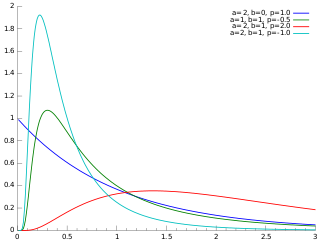Probability density function | |||
| Parameters | a > 0, b > 0, p real | ||
|---|---|---|---|
| Support | x > 0 | ||
| Mean |
| ||
| Mode | |||
| Variance | |||
| MGF | |||
| CF | |||
In probability theory and statistics, the generalized inverse Gaussian distribution (GIG) is a three-parameter family of continuous probability distributions with probability density function
where Kp is a modified Bessel function of the second kind, a > 0, b > 0 and p a real parameter. It is used extensively in geostatistics, statistical linguistics, finance, etc. This distribution was first proposed by Étienne Halphen. It was rediscovered and popularised by Ole Barndorff-Nielsen, who called it the generalized inverse Gaussian distribution. Its statistical properties are discussed in Bent Jørgensen's lecture notes.
Properties
Alternative parametrization
By setting and , we can alternatively express the GIG distribution as
where is the concentration parameter while is the scaling parameter.
Summation
Barndorff-Nielsen and Halgreen proved that the GIG distribution is infinitely divisible.
Entropy
The entropy of the generalized inverse Gaussian distribution is given as
where is a derivative of the modified Bessel function of the second kind with respect to the order evaluated at
Characteristic Function
The characteristic of a random variable is given as(for a derivation of the characteristic function, see supplementary materials of )
for where denotes the imaginary number.
Related distributions
Special cases
The inverse Gaussian and gamma distributions are special cases of the generalized inverse Gaussian distribution for p = −1/2 and b = 0, respectively. Specifically, an inverse Gaussian distribution of the form
is a GIG with , , and . A Gamma distribution of the form
is a GIG with , , and .
Other special cases include the inverse-gamma distribution, for a = 0.
Conjugate prior for Gaussian
The GIG distribution is conjugate to the normal distribution when serving as the mixing distribution in a normal variance-mean mixture. Let the prior distribution for some hidden variable, say , be GIG:
and let there be observed data points, , with normal likelihood function, conditioned on
where is the normal distribution, with mean and variance . Then the posterior for , given the data is also GIG:
where .
Sichel distribution
The Sichel distribution results when the GIG is used as the mixing distribution for the Poisson parameter .
Notes
- Due to the conjugacy, these details can be derived without solving integrals, by noting that
- .
References
- Seshadri, V. (1997). "Halphen's laws". In Kotz, S.; Read, C. B.; Banks, D. L. (eds.). Encyclopedia of Statistical Sciences, Update Volume 1. New York: Wiley. pp. 302–306.
- Perreault, L.; Bobée, B.; Rasmussen, P. F. (1999). "Halphen Distribution System. I: Mathematical and Statistical Properties". Journal of Hydrologic Engineering. 4 (3): 189. doi:10.1061/(ASCE)1084-0699(1999)4:3(189).
- Étienne Halphen was the grandson of the mathematician Georges Henri Halphen.
- Jørgensen, Bent (1982). Statistical Properties of the Generalized Inverse Gaussian Distribution. Lecture Notes in Statistics. Vol. 9. New York–Berlin: Springer-Verlag. ISBN 0-387-90665-7. MR 0648107.
- Barndorff-Nielsen, O.; Halgreen, Christian (1977). "Infinite Divisibility of the Hyperbolic and Generalized Inverse Gaussian Distributions". Zeitschrift für Wahrscheinlichkeitstheorie und verwandte Gebiete. 38: 309–311. doi:10.1007/BF00533162.
- Pal, Subhadip; Gaskins, Jeremy (23 May 2022). "Modified Pólya-Gamma data augmentation for Bayesian analysis of directional data". Journal of Statistical Computation and Simulation. 92 (16): 3430–3451. doi:10.1080/00949655.2022.2067853. ISSN 0094-9655. S2CID 249022546.
- ^ Johnson, Norman L.; Kotz, Samuel; Balakrishnan, N. (1994), Continuous univariate distributions. Vol. 1, Wiley Series in Probability and Mathematical Statistics: Applied Probability and Statistics (2nd ed.), New York: John Wiley & Sons, pp. 284–285, ISBN 978-0-471-58495-7, MR 1299979
- Karlis, Dimitris (2002). "An EM type algorithm for maximum likelihood estimation of the normal–inverse Gaussian distribution". Statistics & Probability Letters. 57 (1): 43–52. doi:10.1016/S0167-7152(02)00040-8.
- Barndorf-Nielsen, O. E. (1997). "Normal Inverse Gaussian Distributions and stochastic volatility modelling". Scand. J. Statist. 24 (1): 1–13. doi:10.1111/1467-9469.00045.
- Sichel, Herbert S. (1975). "On a distribution law for word frequencies". Journal of the American Statistical Association. 70 (351a): 542–547. doi:10.1080/01621459.1975.10482469.
- Stein, Gillian Z.; Zucchini, Walter; Juritz, June M. (1987). "Parameter estimation for the Sichel distribution and its multivariate extension". Journal of the American Statistical Association. 82 (399): 938–944. doi:10.1080/01621459.1987.10478520.
See also









 and
and  , we can alternatively express the GIG distribution as
, we can alternatively express the GIG distribution as

 is the concentration parameter while
is the concentration parameter while  is the scaling parameter.
is the scaling parameter.

 is a derivative of the modified Bessel function of the second kind with respect to the order
is a derivative of the modified Bessel function of the second kind with respect to the order  evaluated at
evaluated at 
 is given as(for a derivation of the characteristic function, see supplementary materials of )
is given as(for a derivation of the characteristic function, see supplementary materials of )

 where
where  denotes the
denotes the 
 ,
,  , and
, and  . A Gamma distribution of the form
. A Gamma distribution of the form

 ,
,  , and
, and  .
.
 , be GIG:
, be GIG:

 observed data points,
observed data points,  , with normal likelihood function, conditioned on
, with normal likelihood function, conditioned on 

 is the normal distribution, with mean
is the normal distribution, with mean  and variance
and variance  . Then the posterior for
. Then the posterior for 
 .
.
 .
.
 .
.